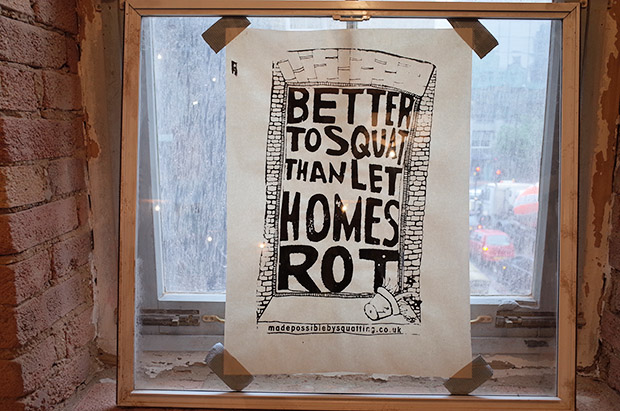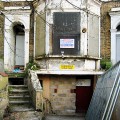
Held in a rather stunning squatted building in East London, the excellent Made Possible by Squatting exhibition sets out to challenge the common media myths and misconceptions of squatters.
The three floor exhibition reflects on the artistic, intellectual and historic contributions of squatting, and features a rich archive of photos, printed material and multimedia content.
At a time when the government – and even slippery, despicable Lambeth Labour politicians – are doing their best to eradicate squatting from the face of the earth, the exhibition serves as a timely reminder of how squatting has positively affected the lives of individuals and communities in London.
Talking to the Guardian, 1980’s South-London based squatter, Hat Smith commented:
Squatting was a way of life – we took pride in looking after our places. Often local people would give us spare stuff, they liked us because we became part of the locality. We helped find squats for vulnerable homeless families and individuals. There were no jobs – Thatcher had seen to that, so we just got on with our creative stuff and used what we could find.
The exhibition website sets out the aims of the show:
London is a city of secrets, of layered, hidden histories. One of the histories of London that remains more obscured and certainly less celebrated than others is that of Squats and Squatters, despite it playing an important part in shaping the city and many of the lives of the people that live here.
Historically, squatting an empty building has been a way to create a temporary home. The occupation of an empty building may last days, weeks or years, but once evicted, buildings are eventually demolished or redeveloped along with the lives that were lived inside them.
Sometimes however, a squatted building or project remains and is allowed to grow, to persist. It may move or be moved on but it remains the legacy of the buildings which made it possible. Bonnington Café, Crossroads Women’s Centre, 56a and Islington Community Housing Co-op are some well-known examples in London alone.
This project seeks to ask what have we already lost? And, what more do we stand to lose if these laws are not fought?
Cafe/main meeting area.
Here’s some more photos from the three floor exhibition. Entry is free, but please be sure to leave a donation at the door.
Banner – as seen at the Brixton Windrush Square anti eviction gathering.
Lost squats and famous actions were remembered in a chain of notes running around the first floor space.
Banenr from the Free School project, which briefly squatted the millionaire movie maker Guy Ritchie’s enormous £6 million mansion in London’s upmarket Fitzroy Square.
Another banner previously seen at the Brixton Windrush Square anti eviction gathering. Sadly, locals were unable to save a large community of squats being evicted by Lambeth’s ‘co-operative’ council earlier this year.
The exhibition is at 15 Dock Street, London E1 8JN and is open to the public until 16 September. More details here.
Related links:
Lib Peck, Chuka Umunna and Tessa Jowell demand commercial property squatting ban (discussion thread)
Labour’s plan to eject squatters won’t fix Britain’s broken housing system (Independent Sept 2013)


